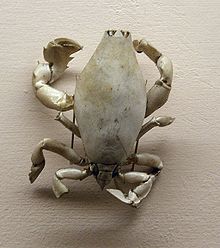| Raninidae Temporal range:
| |
|---|---|

| |
| Lyreidus tridentatus | |
| Scientific classification | |
| Domain: | Eukaryota |
| Kingdom: | Animalia |
| Phylum: | Arthropoda |
| Class: | Malacostraca |
| Order: | Decapoda |
| Suborder: | Pleocyemata |
| Infraorder: | Brachyura |
| Section: | Raninoida |
| Superfamily: | Raninoidea |
| Family: | Raninidae De Haan, 1839 |
| Genera | |
|
See text | |
Raninidae is a family of unusual crabs, sometimes known as "frog crabs", on account of their frog-like appearance. They are taken by most scientists to be quite primitive among the true crabs. They closely resemble the (unrelated) mole crabs, due to parallel evolution or convergent evolution. In both groups, the claws are modified into tools for digging, and the body is a rounded shape that is easy to bury in sand. Unlike most other true crabs, the abdomens of raninids are not curled under the cephalothorax.
They spend most of their time buried in the sand with their eyes popping out so they can grab unaware prey. They also emerge for mating.[1] Raninids are omnivores and some have been found to have consumed Sardinella, crab, shrimp, bivalve, ray, hydroid, copepod, and squid.[2]
The earliest fossil attributable to the family Raninidae dates from the Albian.[3]
- ^ W., Onizuka, Eric (1972). Management and development investigations of the Kona crab, Ranina ranina (Linnaeus) : final report. Division of Fish and Game, Dept. of Land and Natural Resources. OCLC 15024965.
{{cite book}}: CS1 maint: multiple names: authors list (link) - ^ BAYLON, JULIANA C.; TITO, OLIVER D. (2012-07-02). "Reproductive Biology of the Red Frog Crab, Ranina ranina (Linnaeus, 1758) (Crustacea: Decapoda: Raninidae) from Southwestern Mindanao, Philippines". Asian Fisheries Science. 25 (2). doi:10.33997/j.afs.2012.25.2.001. ISSN 0116-6514.
- ^ Andreas Brösing (2008). "A reconstruction of an evolutionary scenario for the Brachyura (Decapoda) in the context of the Cretaceous–Tertiary boundary" (PDF). Crustaceana. 81 (3): 271–287. CiteSeerX 10.1.1.652.1701. doi:10.1163/156854008783564091.